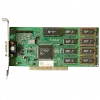The Virtual Reality Graphics Engine (ViRGE) graphics chipset was one of the first 2D/3D accelerators designed for the mass market.
Introduced in 1995 by then graphics powerhouse S3, Inc., the ViRGE was S3's first foray into 3D-graphics. The S3/Virge was the successor to the successful Trio64V+. ViRGE/325 was pin compatible with the Trio64 chip, retaining the DRAM-framebuffer interface (up to 4MB), and clocking both the core and memory up to 80 MHz. In Windows, Virge was benchmarked as the fastest DRAM-based accelerator of the era. The VRAM-version ViRGE/VX was actually slower in lower resolutions, but had a faster RAMDAC to support high-resolution modes not available on the 325.
Part of S3's marketing plan for the ViRGE included the "S3D" standard, stating that members of the ViRGE family carried the S3D Graphics Engine. Games that supported ViRGE directly put this logo on their box so owners of the 3D card would know that it would run as well as possible on their computer. And, despite its lackluster 3D-speed, the ViRGE did receive some S3D enhanced games, due in large part to the brand prestige S3 carried in this period: ViRGE-enhanced versions of Terminal Velocity, Descent 2, Tomb Raider and MechWarrior 2.
While revolutionary in delivering an affordable 3D accelerator with good quality 2D performance, the ViRGE earned the unofficial title as the world's first "graphics decelerator" due to its abysmal 3D performance. While the ViRGE could render basic 3D scenes faster than host-CPU based software rendering, turning on features such as bilinear filtering and Z-depth fogging caused the card to slow down to the point where software-rendering would outrun the ViRGE. To this extent, the practical feature set of the ViRGE range was extremely limited. Ironically, 3D-rendering on the expensive VRAM based ViRGE/VX (988) was even slower than the ViRGE/325 due to the VX's slower core and memory clock rates.
While ViRGE did offer adequate performance in natively-ported titles, in late 1996 the introduction of the 3dfx Voodoo Graphics and Rendition Verité, along with Direct3D's growing significance, changed the playing field for all future 3D-cards. Any chance the ViRGE had of establishing itself as a 3D-gaming platform market effectively disappeared.
The ViRGE was also unpopular for its lack of OpenGL support, limiting visual quality and performance with the extremely popular Quake engine.
Between its birth in 1995 and retirement near the year 2000, the ViRGE family received regular upgrades. The ViRGE/DX boosted the speed of the original ViRGE/325. The ViRGE/GX added support for more modern SD/SGRAM. The ViRGE/GX2 was one of the first VGA chipsets to support AGP, although the level of support extended little beyond electrical compliance. Substantial use of AGP's feature-set would have to wait until the Savage 3D.
The ViRGE was ultimately replaced by the Savage 3D in S3's top-end graphics segment in 1998. However, at least one derivative (Trio3D) of the ViRGE remained in production even after the discontinuation of the Savage 3D.



